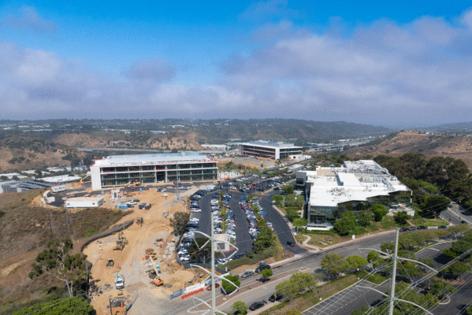San Diego's life science office buildings are sitting vacant. 'We just oversubscribed on space'
Published in Home and Consumer News
A couple of years ago, life science companies were fighting for office leases and developers couldn’t meet the demand fast enough. But now, that hunger for square footage has diminished, and the region’s available office and lab buildings have swelled to an all-time high.
The county’s total vacancy rate climbed to 20.4%, according to a third quarter life science market report by commercial real estate firm Jones Lang LaSalle (JLL). That translates to about 5 million square feet of space waiting to be occupied, out of San Diego’s existing supply of 24.6 million square feet.
It’s nearly double the 10.5% vacancy rate recorded during the same period last year. The amount of available offices and labs has been steadily climbing since 2023, while the demand for these spaces has fallen off sharply.
The total vacancy rate — which includes space put up for sublease — is being driven up by new construction projects and a growing trend of companies offloading space. For some businesses, these real estate decisions were the result of restructurings or financial troubles.
Drug giant Takeda Pharmaceuticals, for example, recently moved out of its 163,648-square-foot building off Towne Center Drive after a restructuring shut down its local research and development office. San Diego-based DermTech previously leased an entire 110,000- square-foot office building in Del Mar Heights. But the company filed for Chapter 11 bankruptcy in June and sold its assets after struggling to secure more financing.
Then there was Cue Health, a COVID-19 test maker that grew its funding, personnel and local manufacturing facilities during the pandemic. The company that was once worth $2.3 billion collapsed in May, resulting in the shuttering of its eight facilities across the county.
It’s a stark contrast to the beginning of 2022, when San Diego’s life science vacancy rate hit an all time low of 1%, or 188,000 square feet. The scarcity of available space in San Diego’s life science core had businesses fighting for leases and paying top dollar.
“San Diego went through an unprecedented amount of construction as it related to life sciences,” said Taylor DeBerry, senior associate of JLL’s life science group. “So really, what happened is we just oversubscribed on space and landlords just started building like crazy.”
DeBerry said the current situation can be traced back to that period of overexuberance. While most businesses were not using their offices during the pandemic, the life science industry had a spike in demand for collaborative spaces.
“Office demands plummeted so in order to save their real estate investments, life science real estate investors came in and started converting buildings … into life sciences,” he said. “So you really had kind of a perfect storm where you had essentially people moving all of their money from (conventional) office space into life science space.”
A couple of developments that entered the market in recent months include Vista Sorrento Labs, a 117,000 square-foot building in Sorrento Mesa, and a 60,000-square-foot building off Towne Center Drive in Torrey Pines. The county’s vacancy rate doesn’t include projects under construction; those are reflected in the availability rate, which is also at a record high of 26.8%.
A big part of this construction boom stems from record levels of venture capital financing in 2021 that led to unprecedented growth for life science companies.
During the third quarter of this year, San Diego recorded about 3.8 million square feet of life science space under development. In the third quarter of 2019, there was just under 700,000 square feet in development.
While San Diego’s life science startups continue to rake in more than $1 billion in venture capital deals each quarter, it’s a steep decline from a few years ago when startups brought in twice as much funding. There are fewer deals being recorded and that money is rarely going to early-stage startups.
There is still money waiting to be deployed, but investors are not taking risks like they were during the pandemic. This year, high interest rates and the runup to the U.S. presidential election have led investors and companies to tighten their belts.
Though leasing activity remains tepid, there was a slight increase in demand during the third quarter. The handful of recent leases were under 70,000 square feet and most were for companies growing their footprint.
For example, Mirador Therapeutics — a biotech that launched with $400 million — signed a new 66,000-square-foot lease in Sorrento Mesa. Although some companies have failed this year, DeBerry said the ones moving forward have more promising futures.
“I think it’s similar to what you’d experience in a forest fire, where the trees get burned but then new sprouts start to grow,” DeBerry said. “Some of the companies that are out there looking for space right now have signed strategic partnership deals with big pharma companies. You’re seeing a lot of that and that’s resulting in tenant demand.”
DeBerry expects that San Diego’s vacancy and availability rates will continue to climb as more projects get delivered, and they won’t come down any time soon. While it’s been difficult to attract life science tenants in general, it’s been especially challenging for new downtown buildings beyond San Diego’s prime biotech neighborhoods.
The RaDD IQHQ campus on San Diego’s waterfront is a 1.7 million-square-foot project centered on life science labs and offices. The complex also offers retail, dining and green space.
The Campus at Horton is a 10-acre mixed-use development in the heart of downtown that has plans for life science offices in addition to two 40-story apartment towers and retail.
Both of these downtown developments are outside San Diego’s traditional biotech cluster and have not announced any life science tenants.
Experts say tenants have the power in this kind of market and are able to get premium spaces at a cheaper price. The overall asking rent in San Diego County has dropped for the ninth straight quarter, according to JLL.
“Whenever there is oversupply, you will see the tenant with more power to negotiate,” said Daniel Maldonado, managing director at Unispace Life Sciences. “Tenants are flying to high-end spaces because they can find little deals.”
Maldonado’s firm designs spaces for biotechs and big pharmaceutical companies across the globe. He said the imbalance of supply of life science space and demand from companies right now is not unique to San Diego.
The country’s other top two life science markets, Boston and San Francisco, are experiencing similar trends. However, Maldonado is optimistic that San Diego will bounce back more quickly over the next year because its vacancy and rental rates are lower than other major markets.
By comparison, Boston’s total vacancy rate was 28.4% during the third quarter, and overall asking rent was $86.02 per square foot. San Diego’s average asking rent was $5.85 per square foot.
“I am really convinced that this short-term problem — the vacancy rate — is going to be overpassed by a long-term, growing demand because long-term projections for San Diego” show promising employment growth in life sciences, Maldonado said.
©2024 The San Diego Union-Tribune. Visit sandiegouniontribune.com. Distributed by Tribune Content Agency, LLC.








Comments